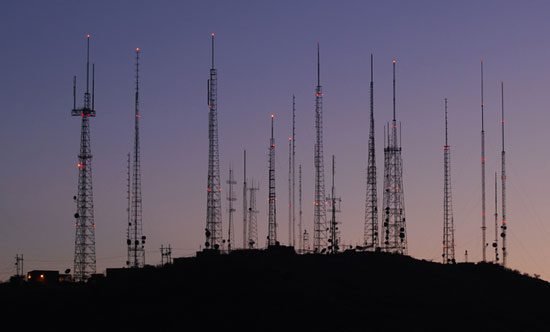This is the first part of many types of antennas which weren’t showed before, This post’s name could be called “Antennas (Part 3)”.
To see the first posts about antennas, click in the buttons below.
Spiral antenna

Basically it is a dipole antenna with wrapped arms. Has a very broad bandwidth, which can have until 30 GHz and are circularly polarized. This is the radiation pattern of spiral antennas, has a half power band width (HPBW) between 70º and 90º.

The two main types of spiral antennas are: Log-Periodic and Archimedes. This is an Archimedes spiral antenna.

The antenna’s radius is proportional to angle \varphi. The first arm is represented by the equation:
r=a\varphi +r_{1}
This is the second arm’s equation.
r=a(\varphi-\pi ) +r_{1}
a=\frac{s+w}{\pi }
The dimensions of this antenna can be calculated by the equation below:
s=w=\frac{r_{2}-r_{1}}{4N}
- N is the number of turns.
The lowest frequency of Archimedes spiral antenna is given by the formula:
f_{B}=\frac{c}{2\pi r_{2}}
- c is the speed of light in vacuum, which is 3\cdot 10^{8} m/s.
This is the formula to highest frequency.
f_{A}=\frac{c}{2\pi r_{1}}
This is the Log-Periodic spiral antenna.

Each arm from this antenna is represented by this polar function:
r=R_{o}e^{a\phi }
Where R_{o} is the antenna’s internal radius. The highest operation frequency is calculated in the following way:
f_{B}=\frac{c}{2\pi R_{e}}
R_{e} is the spiral radius. The highest frequency is calculated in the form below.
f_{A}=\frac{c}{4R_{o}}
The spiral antennas are used in GPS, missiles and electronic warfare as radar warning receivers or jammers.
Yagi-Uda antenna

Everyone have seen this type of antenna, it is formed by a dipole and various conductive bars in parallel, called parasite elements. Has a high gain and directivity, usually operates in frequency band between 30 MHz and 3 GHz. Only the dipole is linked to the circuit, the back bar serves as reflector and the front bars are directors.

The typical radiation pattern of Yagi-Uda antenna with 2 directors.

Increasing the number of director bars, increase directivity.


To design an Yagi-Uda antenna, the parameters to be considered are:
- Wavelength \lambda;
- Reflector length;
- Distance between reflector and dipole;
- Dipole total length;
- Distance between dipole and the first director;
- Distance between directors;
- Director’s length.
These values affect the gain, must be related to wavelength, for example, the reflector length is 0.56\lambda. Many sources indicate different proportions to parameters design. Other types of antennas will be explained in the next parts.


